Bwindi Impenetrable National Park is the most sought after world class tourist destination as it harbors more than a half of the world’s surviving mountain gorillas listed as a critically endangered species. Recognized by UNESCO as a world heritage site in 1994, Bwindi (Which locally refers to darkness or impenetrable) was since 1942 a forest reserve before it was elevated to a full national park in 1991. The 321k2 national park is characterized by tangled vegetation draped over a deeply fissured landscape of steep slippery valleys and high drought ridges. It’s ever chilly weather and challenging terrain offers unequaled ambiance and serenity for the visitors seeking to meet and interact with their closest cousins. A trek through one of Africa’s most ancient rain forests, in search of the endangered Mountain Gorillas, ranks among the world’s premier wildlife encounters.
ATTRACTIONS
Flora and Fauna
Bwindi supports a tremendous biodiversity as a result of three major factors. Its slopes extend over a broad attitudinal range of 1,447m to create habitats ranging from lowland forest at 1,160m to rare Afromontane vegetation above 2,600m. It is also extremely old and part of the exceptionally rich Albertine Rift Endemic area. When most of Africa’s forests disappeared during arid conditions of the ice age (12,000 -18,000 years ago), Bwindi was one of the few ‘refugia’ that persisted. Consequently, while most of today’s forests are no more than 12,000 years old, Bwindi’s vegetation has been weaving itself into tangles over at least 25,000 years, in the process accumulating a lengthy species list. This list includes 310 species of butterflies, 51 reptiles, 200 trees, 88 moths and 120 types of mammals.
Mountain Gorillas
Mountain gorillas live in structured groups with defined home ranges. Bwindi has ten habituated gorilla groups that are tracked by tourists. Three of these are in the vicinity of Buhoma, three at Ruhija, while other four are tracked from the southern sector (Nkuringo/Rushaga)
Primate World
The Park boasts 10 species of primates including the mountain gorilla, chimpanzee, baboon, L’Hoest, red-tailed, blue monkey, black and white Colobus and the nocturnal bush babies.
Birding
Bwindi is a habitat for a variety of birds with over 350 species recorded, including 23 endemics (90% of all Albertine Rift endemics) such as the short-tailed Warbler, Shelly’s Crimsonwing, African Green Broadbill and Blue-headed Sunbird as well as seven IUCN red data listed species. Easy to see are the African Emerald Cuckoo, African Blue White-tailed Flycatchers and Red-headed Bluebill.
ACCESSIBILTY
By Roads
The Park is about 530kms from Kampala city and can be reached by road from several directions that include: through Queen Elizabeth National Park (Mweya) – via Kihihi to Buhoma.
From Kampala you can also access It via Kabale through Kanungu to Buhoma (5-6 hour journey); Ntungamo via Rukungiri through Kihihi to Buhoma (5-6hour journey); via Kabale-Ruhija-Buhoma (S-6hour journey); Kabale-Nkuringo (6-7hour journey); Kisoro-Rubuguri/Nkuringo 2 hour journey).
Note: a 4×4 vehicle is recommended for a Bwindi visit.
By Air
From Entebbe Airport or Kampala (Kajjansi airfield) to the tarmac airstrip at Kisoro town, Visitors to Buhoma can also charter planes to Kayonza (near Butogota) or Savannah (Kihihi) and Ishasha airstrips.
ACCOMMODATION
- Sanctuary Gorilla Forest Camp
- Silverback Lodge
- Buhoma Community Rest Camp
- Chameleon Hill Lodge
- Nkuringo Bwindi Gorilla Lodge
SPECIALIZED TOUR OPERATORS






















7 Comment
Wild Jungle Trails Safaris, 2019-08-09 at 10:59 AM
Uganda gorilla trekking permit prices increased to 700 USD effective July 2020 – Travel News
The Uganda Wildlife Authority (UWA) announced an increase on the Uganda gorilla trekking permit prices from the current 600 USD to 700 USD effective 1st July 2020 for foreign non residents. From 1st July 2020 each foreign non resident planning to take a gorilla tour will pay 700 USD per person per trek for both Bwindi Impenetrable National Park and Mgahinga Gorilla National Park.
Frithjof V, 2016-03-26 at 8:20 AM
Very nice park, visiting the wild gorillas was very exciting, the guides were really good and I can highly recommend this experience. Better than a normal safari in my opinion.
Ivy G Fort, Florida, 2016-02-27 at 8:26 AM
Expensive but worth it. The hike was quite steep, but pole pole you’ll make it. Being with the gorillas (Nshongi group) was such a rare, special experience. I’ll always treasure it. Bwindi is also very beautiful just on it’s own which made the sometimes strenuous hike beautiful/much more bearable. If you have the money, this is highly recommended!
Vicky, USA, 2015-11-20 at 4:03 AM
We went as a family during the gorilla permit promo, a total of 4 people, to “do” the ever unforgettable gorilla tracking and it was never a appointment. This was a thoroughly enjoyable experience, with helpful and knowledgeable guides. The gorilla sightings were unforgettable. Bwindi forest was cold and rainy, very challenging but you wont regret.
Jose, 2019-09-06 at 12:39 PM
Great experience, what a great trip to Bwindi gorilla forest, I definitely recommend anyone visiting Uganda or Rwanda
Deepesh, Hydrabad, 2015-06-27 at 4:10 AM
The big predators are roaming freely and happily in groups eating green vegetables, They look so health, one of the reason I’m vegetarian 🙂 we sighted alot of birds too, Chameleon also. I want to visit Bwindi again
Mathew and Prisca Poland, 2014-07-04 at 8:17 AM
Great experience, what a great trip to Bwindi gorilla forest, I definitely recommend anyone visiting Uganda or Rwanda but we had to extend our stay IMPORTANT: Booked in Advance. we got there when the gorilla permits where finished we had to book 4 days later, so please talk to your travel agent Most probably you will not get last minute bookings.